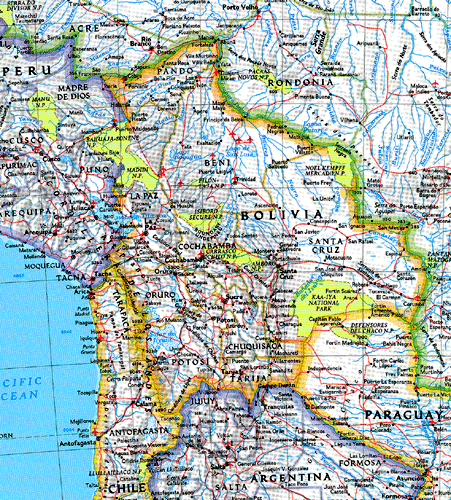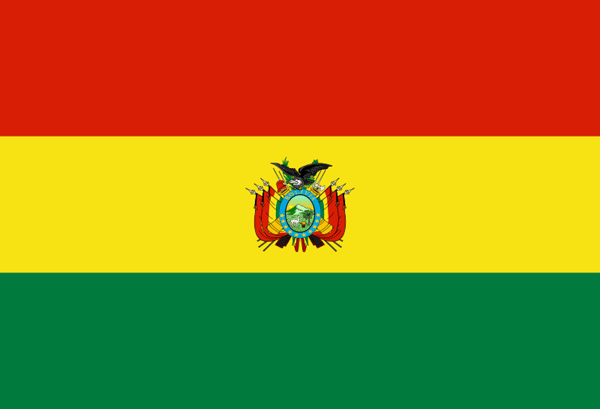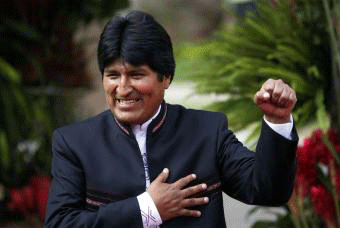BOLIVIA
|
|
|
NAME: Bolivia (Estado
Plurinacional de Bolivia)
Official
legal name: named for liberator of northern South America, Simón Bolívar; name
in Quechua: Bulivya Mamallaqta; name in Aymará: Wuliwya Suyu
POPULATION: 11,400,000 (2015)
ETHNIC
GROUPS: White (15%; Spanish
mostly); Mestizo (23%); Indigenous (62%): Quechua (30%), Aymará 25%, Guaraní (8%)
CAPITAL: La
Paz (administrative capital, 2,000,000); Sucre (constitutional capital)
INDEPENDENCE DAY: August 2, 1825 (independence from Spain)
LANGUAGES: 4 official languages: Spanish, Quechua, Aymará,
Guaraní
RELIGION: Roman Catholic (95%); Protestant (5%).
LIFE EXPECTANCY: Men (64); women (70)
LITERACY: 87%
POVERTY: 60% of the population is below the poverty
line.
GOVERNMENT: Democratic republic
Legislature: Plurinational Legislative Assembly (Senate and Chamber of
Deputies)
President: Juan
Evo Morales
MILITARY: Army (Ejército Boliviano), Navy (Armada Boliviana), Air Force (Fuerza
Aérea Boliviana)
ECONOMY: Coca (world's third largest
producer and exporter); soybeans, coffee, cotton, corn, sugarcane, rice,
potatoes, wood, mining, petroleum, tobacco, handicrafts
Bolivia
is one of the poorest nations in the world; 64% live below the poverty line.
MONEY: boliviano (BOB) (7.1 =
$1.00 US, 2010)
GEOGRAPHY: Bolivia is bordered, clockwise
from north and east, by Brazil, Paraguay, Argentina, Chile, and Peru; Bolivia
has no access to the any ocean. Much of Bolivia is in the Andes mountain chain
at a very high elevation. Lake Titicaca is 12,500 ft
above sea level; it is the highest commercially navigable lake in the world,
and it is the largest lake in
INTERNET
CODE: .bo
CALLING
CODE: +591
HISTORY:
200
BCE-1000 Tiwanaku civilization, with a
population up to one million. It was a an agricultural society centered around
the
600-950 Tiwanaku was the regional capital
of the Tiwanaku (early Aymará) people. The city had a population of between
15,000 and 30,000 inhabitants, and it governed a region that covered modern
southern Perú, western Bolivia—and Lake Titicaca that crosses the modern
borders—and extreme northern Chile.
1000-1400 People in the Beni region of Bolivia
"built roads, causeways, canals, dikes, reservoirs, mounds, raised
agricultural fields, and possibly ball courts" (Charles C. Mann, 1491, New York: Knopf, 2005, p. 5). For
a map of the Beni region, link to this URL in Maplandia: => Beni.
1438-1527
Quechua and Aymará (Tiwanaku)
peoples began to come under the dominion of the Inca empire centered in Perú
and running along most of the Andes mountain chain.
1542 Bolivia was claimed by Spain
and was incorporated into the Viceroyalty of Perú. Bolivia proper was called
Upper Perú until 1825.
1545 Diego Hualpa (llama herder?)
accidentally found richest vein of silver in history: 300 ft. long, 13 ft.
wide, 300 ft. deep. The native peoples taught the Spanish colonists how to
refine such rich silver ore (50%)
1546 Potosí (officially: Villa
Imperial de Potosí) was founded as a city due to a fabulously rich silver mine.
The name became synonymous with fabulous wealth. In 1611 the population of the
new mining city reached 160,000. Today the city of Potosí (13,000 ft elevation)
has a population of 15,000. Silver from Bolivia helped fund the Spanish empires
control of its worldwide colonies, its monarchy, and its European expansion and
wars. Native Bolivian people constituted the brutal slave-like labor force in
the silver mines. The system by which native people were forced to work in the
mines was called the mita. Two images
of the main silver mine called Cerro Rice, which rises above the town/city of
Potosí:
|
Pedro Cieza de León woodcut
(1553) |
|
|
Charles C. Mann, in
his crucial work, 1493 (Knopf, 2011) says this about Bolivian silver: “One
account describes how a single shipment of 7,771 bars left the [Potosí] in 1549
… Each bar was about 99 percent silver and weighed more than eighty pounds. All
were stamped with serial numbers by the foundry and marked with the owner’s
stamp, the foundry stamp, and the tax man’s stamp. By the time the assayer
individually certified its purity with his stamp, the bar looked as if it had
been graffiti-tagged by a demented numerologist. Each llama could carry only
three or four bars. …The shipment required more than two thousand of the
beasts. They were watched by more than a thousand Indian guards who in turn
were watched by squads of Spanish pistoleros” (148).
1556 -
1783 45,000 tons
of silver were mined from the mine at Cerro Rico alone in Potosí. In all,
Bolivian silver mines during these two centuries yielded over 150,000 tons of
silver that flooded the world money markets and was instrumental in spreading
the Columbian Exchange because silver became the main currency in Europe, the
Spanish, Portuguese, Dutch, and French empires. Furthermore, Spanish silver
coins formed the core of the Philippines and China, notably in the Chinese
province of Yuegang in Fujian.
1825 Bolivia got its independence from
Spain due to the military victories by Simón Bolívar.
1825 -
1982 During these 157 years Bolivia
was rules by more than 160 presidents or dictators.
1836-1839 Bolivia and Perú formed the Peru-Bolivian
Confederation, but this confederation collapsed when Argentina and Chile
invaded.
1879 -
1883 Bolivia became a landlocked
country when it lost the Guerra del Pacífico (War of the Pacific) to Chile and
Perú.
2006 –
2018 Juan Evo Morales elected president. He is an Aymará, the first indigenous ruler ever
in Bolivia. The presidential term was only two consecutive terms, but in 2008,
the Bolivian constitution was amended to allow more than two consecutive terms;
hence, president Morales was re-elected in 2010 and again in 2014.
|
|
|
El presidente de Bolivia, Evo Morales, en octubre
(Reuters) from El País, April 4, 2010, p. 8. |
2010 Municipal and regional elections: majority of election
races won by the MAS; as a result of these election results, President Evo
Morales has sufficient political margin of support and momentum in order to
enact a sweeping regional redesign to give more autonomy to the regions and to
indigenous populations.
PRINCIPAL
POLITICAL PARTIES:
Free Bolivia Movement / MBL;
Movement Towards Socialism (MAS); Movement Without Fear (MSM); National
Revolutionary Movement (MNR); National Unity (UN).
MAJOR MEMBERS
OF INTELLIGENTSIA:
Writers: Guzmán de Rojas, Arturo
Borda, María Luisa Pacheco, Marina Núñez del Prado




